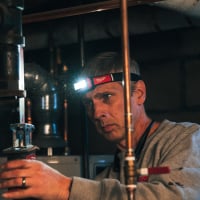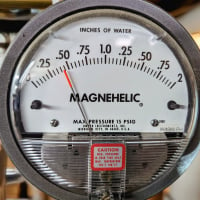Torque Wrench

Forty-five years in the trade and I don't own a torque wrench. And I don't think any heating contractors in my area have one either.
Torque spec's. aren't always stated. I see them mostly on Viessmann instructions.
Triangle Tube HX bolts seem to be the most sensitive, i.e. too tight and they will shear off. Hand tight with another half turn with a socket set is good; check for CO in the cabinet.
Wondering if I really need one or is it going to be another tool that gets lost in my truck.
Two btu per sq ft for degree difference for a slab
Comments
-
It's in the electrical code to torque electrical connections as well. Been in there a while. Most electricians don't have any torque screwdrivers. I don't have one and not getting one.
0 -
a 1/4" drive torque wrench and an adapter to 1/4" insert bits will do what you need for the cover on a mod con hx and is inexpensive.
torque is a proxy for the tension on the fastener and isn't the greatest proxy but is better than nothing. it is something we could discuss for hundreds of comments. on something like the cover to a mod con hx or the plate for a tankless or rods holding sections of a boiler together is it good to try to get equal clamping force all around.
the other reason torque is important is that you want the fastener to be stretched more than it will be stretched in use. If the stretch of the fastener is greater than the forces in use it stays tight, if the forces in use are more than the tightening tension, it will loosen up.
a lot of things will have a lot of variables in how they turn and making sure they are seated properly is more important than the torque
0 -
never heard
Torque Wrenchand Boiler in the same sentence. It's a changing world.
1 -
-
Non-HVAC related but I've seen torque wrenches cause problems..
Either because fasteners weren't clean, or they were or weren't lubricated or the wrench wasn't working correctly.Often, an experienced mechanic can do work just fine without one.
Single pipe 392sqft system with an EG-40 rated for 325sqft and it's silent and balanced at all times.
0 -
If you've assembled large sectional boilers, they always want the bolts & rods torqued..md
2 -
and usually with very specific thread condition (lubed or not, or with what) and in a specific pattern. Same reasoning as such prestress critical applications as cylinder heads, crankcase through bolts, main bearing caps, etc.
Br. Jamie, osb
Building superintendent/caretaker, 7200 sq. ft. historic house museum with dependencies in New England2 -
like i said, we could talk about this for 200 + comments
0 -
-
If it makes you feel better, no harm in owning an inexpensive torque adapter. Over tightening, by the guess method, is more of an issue with 6 mm bolts and aluminum block boiler, I would say.
I wish more tire shops would pay attention to torque specs :)
Bob "hot rod" Rohr
trainer for Caleffi NA
Living the hydronic dream4 -
-
There are many doods still flaring mini line sets w-o a torque wrench. I started using one about 8 years ago, I thought it was revolutionary!
2 -
With the equipment you are installing, is it required tooling to have for warranty claims ?
National - U.S. Gas Boiler 45+ Years Old
Steam 300 SQ. FT. - EDR 347
One Pipe System0 -
-
That's the only thing I used a torque wrench for was putting a CI boiler together. Lots of variables with a torque wrench. How you pull or push, lube etc those little thing can throw things off by a mile.
1 -
I have never seen any boiler assembly bolt or rod a mile long… You must work on some big stuff Ed. the longest push nipple assembly rod I have ever used myself was about 14" long. but I only worked on a couple of churches myself. The Catholics had the biggest churches in my area.
Edward Young Retired
After you make that expensive repair and you still have the same problem, What will you check next?
0 -
-
-
I use a CPS BlackMax for mini split flare connections. I can't say I ever used it on a boiler. Anytime I see a tankless coil plate on a boiler I reach for my 9/16" to see if I can tighten up the nuts/bolts and prevent it from leaking.
0 -
-
Had a guy helping me once he was really strong.
I was cutting and threading 3" pipe for a boiler return header and he was putting the fittings on.
By the time he got through the thing was too short. I am rechecking my measurements trying to figure out what went wrong and he told me.
"I was told by my buddy (another pipefitter) to crank the pipe into the fitting until no threads are showing"
3 -
-
Any trouble with the torque setting for ¼? I've found that if I use the numbers in the book, it'll push the flare out of the nut as often as not, even with the flare the right depth.
0 -
Torque is important on fiber gaskets as they have a built in "compression set" too much torque flattens the washer so it cannot accept thermal expansion/ contraction. Mixing valves are a classic fiber gasket leak potential.
Not enough torque and the gasket does not make the seal. Clean surfaces are critical!
Caleffi is changing to a Posi-stop o-ring. with this design the brass machining limits the amount of "squeeze" you put on the o-ring. The o-ring manufacturer builds the O- ring to a certain % of compression. The same concerns with an o- ring, the compression can be too great or to little.
The type of material and the durometer (hardness) are part of the seal design. Pressure, temperature, type of fluid, movement are all considered in hydronic and plumbing gasket design.
A stop or torque wrench is the only way to know you have the correct seal compression.
Bob "hot rod" Rohr
trainer for Caleffi NA
Living the hydronic dream2 -
@ratio no problem so far, but this is the first year I have been using it. I used it today on a Mitsubishi system and if I remember correctly the specifications were something like 32-40 ft/lb for 5/8" and 10-15 ft/lb for 1/4". It seemed like I had to excessively crank on the 5/8" to get above 32 ft/lb and I had to tighten the 1/4" flare nut less than usual to get to the specified torque. I haven't had a chance to pressure test the system so I'll have to see how that goes.
What are your thoughts on using a little Nylog or POE oil on the flares? Someone said that affects that can cause you to over tighten the flare nut with a torque wrench.
0 -
I've done flares both ways, with Nylog (on the sealing surface) & without, also with torque wench & without. I might've exaggerated how many times I've pushed the flare out, but for sure several times, with the torque wench. Any more I just go to 8-9 inch/lbs on the ¼".
I can imagine the lube causing some issues if it's all over the place, but a dab on the sealing surface shouldn't be an issue. I've tried those li'l blue gaskets too, the jury is still out. They do need to be torqued properly though, they will leak if not.
0 -
I love using torque wrenches. It is a useful tool that you can use with wet torques, dry torques, and if you dont have a specified torque, just look it up in torque tables. Out of fifteen mechanics, Im the only one with torque wrenches that frequently gets borrowed. I'm also the oldest.
One time I didnt use one on my lug nuts and I overtightened them and warped the rotors. That was expensive.1 -
I got one when I started doing mini splits. The YJ digital one. I don’t like that you can easily and accidentally change the units, especially if the wrench is in a position where you can’t see the display.
0 -
I also use a torque on flair nuts , It made a difference on leaks ..
There was an error rendering this rich post.
0 -
I have been building cast iron sectional commercial boilers at least a few times a year since the 1980's. The first time I used a torque wrench on the draw bolts on Smith 28 cast iron water boiler that was going through at least two cast iron sections per season. We were hired as the "expert" trouble shooter that could determine why these sections were failing so often on a three year old boiler. I was amazed how tight the manufacture's wanted the nuts. Before this job, I realized that I was tightening the nuts to about seventy or eighty pounds (without a torque wrench). Somehow, we did not have leaks with under-torqued draw rods.
We used an old Craftsman 1/2" drive torque wrench for years when assembling cast iron boilers. Always amazed me how tight Weil McLain wanted them on 76, 78, 80, 86, 88, 92, 94 and LGB cast iron boilers. Over time, you get pretty good at guessing how tight things are by feel.
1 -
we measure the spring tension on the Z-one zone valve in inch ounces. Too little tension and they can leak by. Too much tension, closes too fast and can cause water hammer
Bob "hot rod" Rohr
trainer for Caleffi NA
Living the hydronic dream0 -
I remember when the 28s first came out. First one I saw was around 1975ish. Originally Smith had no torque spec for the 28s. A couple of years late we were called in to fix leaks on a 28 not our install. By this time Smith had torque specs. They had overtightened the lower push nipples and you could see cracks across the sections. I called Smith (the old foundry was only 10 miles away) and they came over and looked at it. Had me spray with penetrant. I think it was about 15 section boiler with about 5 cracked sections. We split the block in half and replaced the two that leaked. It was a PITA because it had the long tankless heater installed in the 6" rear tapping that ran the length of the boiler and we had to pull that.
The insurance company would only pay for the 2 sections that leaked so that is what we did. When the insurance inspector showed up he wanted me to retorque the entire boiler including the sections that were cracked but not leaking.
I refused and handed him the torque wrench and said "go ahead you do it".
I think we went back a year later and did some more sections. Too long ago to remember. Trying to remember the torque specs like 130 on top 30 on the other top and 50 at the bottom??
1 -
@EBEBRATT-Ed I forget the torque specs on the 28 series, been a long time. With Weil McLain, we just did an LBG, book says 100 to 120lbs on upper and lower.
0 -
-
it doesn't matter. the crowfoot is a lever that is around an inch long regardless of its orientation to the handle. unless you add another lever the same length toward the center of the crowfoot, the crowfoot is going to increase the torque a little. probably not enough to be significant in all the other variables that make torque only an approximation of the tension on the fastener.
0 -
True. But if the plane crashed six months later because of something totally unrelated to your work, you will still be interviewed by investigators and that is not the answer you want to give. It could cause you a suspension of license
0 -
interesting. I always grab the wrench at the handle only.
1
Categories
- All Categories
- 87.4K THE MAIN WALL
- 3.2K A-C, Heat Pumps & Refrigeration
- 61 Biomass
- 429 Carbon Monoxide Awareness
- 120 Chimneys & Flues
- 2.1K Domestic Hot Water
- 5.8K Gas Heating
- 115 Geothermal
- 168 Indoor-Air Quality
- 3.7K Oil Heating
- 77 Pipe Deterioration
- 1K Plumbing
- 6.5K Radiant Heating
- 395 Solar
- 15.7K Strictly Steam
- 3.4K Thermostats and Controls
- 56 Water Quality
- 51 Industry Classes
- 50 Job Opportunities
- 18 Recall Announcements













